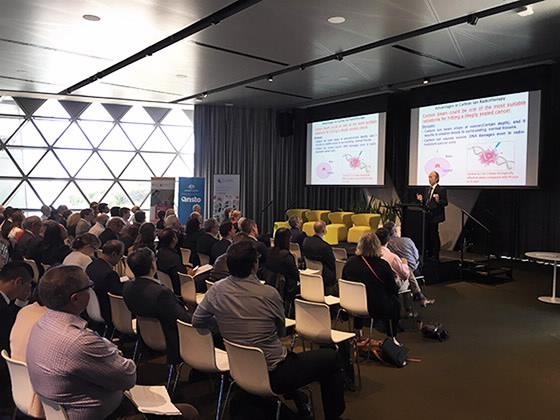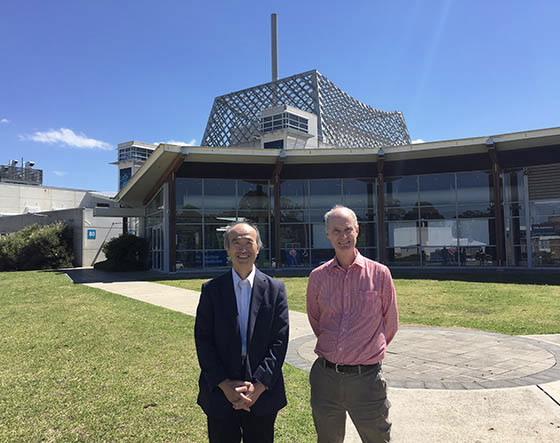
Published on the 7th November 2017 by ANSTO Staff

The event brought together medical and health experts from across Australia and New Zealand, to discuss emerging advances in patient treatment, clinical trials and technology, including from:
- The Australian Nuclear Science and Technology Organisation (ANSTO);
- The South Australian Health and Medical Research Institute (SAHMRI);
- The NSW Health Western Sydney Local Health District;
- The Queensland Health Metro North Hospital and Health Service; and
- The Royal Australian and New Zealand College of Radiologists.
SAHMRI executive director, Professor Steve Wesselingh, said the day was an opportunity for industry leaders to discuss the way forward for particle therapy in Australia.
“Particle therapy uses a targeted beam of high-energy particles that can kill cancer cells without damaging surrounding healthy tissue,” Professor Wesselingh said.
“It is a more effective treatment for a range of cancers and is especially beneficial to patients suffering from brain cancer, and infants and children whose organs are still developing.
“There are more than 70 operational particle therapy facilities around the world, and a further 40 currently under construction.
“It’s an exciting time for Australia, thanks to significant funding from the Federal Government earlier this year to build the country’s first particle treatment facility in South Australia by 2020.”
Attendees also heard from Dr Takashi Murakami who explained the latest developments of particle therapy for cancer treatments in Japan using carbon ion therapy and real-time motion tracking of the tumour position during treatment.
Carbon ion therapy is considered a game changer by researchers, for its ability to destroy cancer cells that that are resistant to conventional radiation therapies.
Japan has been using particle therapy techniques since 1994 and is considered a world-leader in the field.

ANSTO’s Dr Richard Garrett said the workshops held today contributed to the ongoing conversation about Australia’s particle therapy capabilities.
“It’s vital to keep the communication lines open between governments, health services, research organisations, universities and Royal Colleges, in order to maximise the best possible outcomes for Australian patients,” Dr Garrett said.
“We see the ideal model as a landmark national particle therapy and research centre, for both life-changing patient treatment options and research, supported by state-based proton particle therapy facilities.
“A national particle therapy and research centre would help thousands of Australians now and into the future, and we as heard from Dr Murakami ongoing research is an important component.”
“It's time for Australia to be part of the next great wave of cancer treatment,” said Dr Garrett.
For media enquiries, please email media@ansto.gov.au
BACKGROUND ON A NATIONAL PARTICLE THERAPY AND RESEARCH CENTRE
- Conventional radiotherapy uses high energy radiation, usually photon beams, to destroy cancer cells or impede their growth. It has a major role in modern cancer management.
- Particle therapy is a class of treatment that kills cancer cells - using protons or other charged ions, such as carbon, with minimal side effects.
- Carbon ion particle therapy is an advanced form of particle therapy used to treat cancers located close to critical structures such as the eye, and other previously considered inoperable tumours, as well as those resistant to conventional radiation treatment. It demonstrates superior clinical advantages over conventional radiation therapy because:
- It provides a higher dose of radiation which increases with depth to a sharp ‘energy peak’ at the precise tumour location, minimizing the dose to healthy tissue in front and behind the tumour, even if the healthy organ at risk is in very close proximity to the tumour;
- it has an improved Relative Biological Effectiveness (RBE) compared to conventional radiotherapy, making it up to 3 times more effective at killing cancer cells for the same level of dose delivered compared to x-rays;
- there is little spread of radiation beyond the specifically targeted tumour site, therefore minimising damage to surrounding healthy tissue, reducing side effects and the risk of secondary tumours;
- the delivery of the therapy can be controlled precisely to match the exact size and shape of the tumour, with accuracy to less than a millimetre;
- fewer procedures are required because of the stronger effective radiation dose and sparing of the healthy surrounding tissue; and
- with less time in care, the burden on both patients and the health system is reduced.
- The carbon ions are accelerated to up to 75 per cent the speed of light in a synchrotron particle accelerator, before being delivered to the patient in a well-focused and targeted particle beam.
- At present, if an Australian patient with an inoperable or radiation-resistant tumour needed to receive carbon ion or other particle therapies, they would need to travel overseas to do so.
- A proton therapy centre, the first of its kind in the Southern Hemisphere, will be established in Adelaide, following commitments from the State and Federal Government earlier this year.
- There are more than 70 operational particle therapy facilities around the world, and a further 40 currently under construction.
- Accelerated particles also have non-clinical applications, such as research into advanced cancer and novel radiosurgery therapies, radiogenomics and radiobiology (how radiation interacts with living tissues), and in industrial research e.g. advanced materials development, semiconductor electronics testing and avionics.